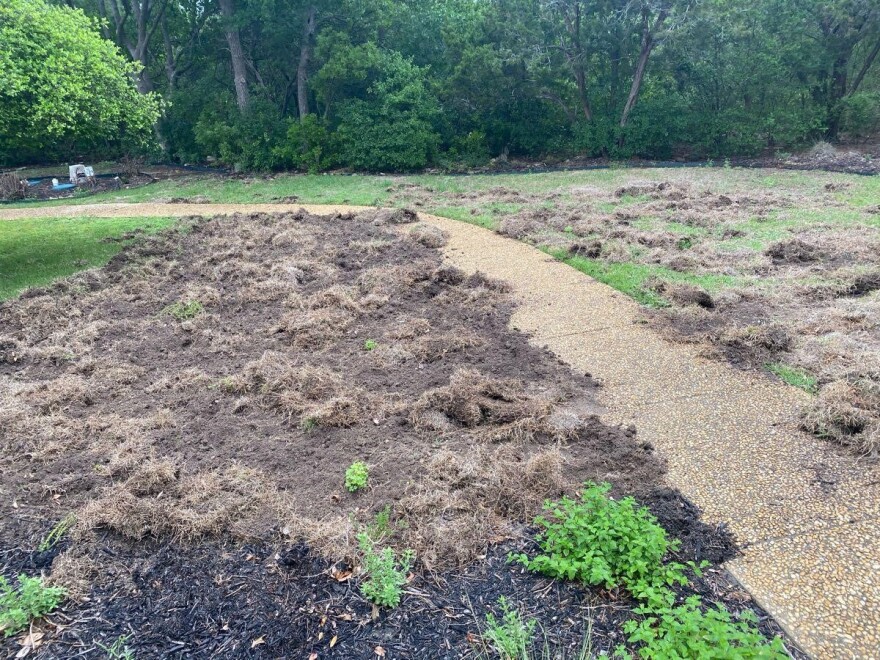Critics called it the “pig bomb” The growing numbers of feral hogs in Texas have become a huge problem.
There are an estimated 2.6 million feral hogs in the state, or half of the total U.S. hog population, according to research from Texas A&M University.
The critters can now be found in 99% of Texas counties, and it’s now estimated they do $52 million in yearly damages to Texas agricultural enterprises.
But it’s not just farms that are getting damaged. It’s not uncommon for the hogs to invade neighborhoods during late night raids, tearing up yards and landscaping, and creating hazards for people and their pets.
“You don't hear them," said Frederick Mendler, who lives in the Shadow Canyon subdivision in northwest Bexar County. "You don't know. You wake up, and you walk past your front door to get your morning coffee, and you notice something amiss outside your front door. Then, your heart sinks and you realize that the damage is done.“
Feral hogs have destroyed his yard many times.
“You got to spend the next couple of hours of your day really, really stomping down the grass and trying to reset it and then water it and put it all back together so it won't die," he explained.
"But the problem is they'll do that on a Monday. Go to bed Monday night, Tuesday morning. Guess what? They came back again. And then you did it on Tuesday. You spent half a day fixing the yard. Then they came back on Wednesday again. So, you know, I've had this happen three or four days a row where I finally just give up and just let them have it.“

"Years ago, people thought it would just be [unheard] of that you'd see hogs in the city," said Sam Womble, a county extension agent with Texas A&M Agrilife.
He said that encounters with pigs were rising.
“As we get more people in the state of Texas, we have a growing population and our wild pig populations kind of continue to increase," Womble explained, "the chances are that there's going to be more interaction, you know, with humans and wild pigs in some of these suburban areas.“
He said that feral hogs are smart, adaptable and they breed quickly. “They can have their first litter of pigs when they are 12 to 13 months of age," Womble added. "It's not uncommon that they'll have a couple of litters a year.”
Todd Mathews manages Valkyrie Trapping, a service that will visit a home and set up traps for the hogs. He said business was booming.
“I'm telling you, the moment that I put my name out there as someone with traps for a hog, I haven't slowed down since," he said. "We're going on eight years now, and our business has grown substantially every year. I currently employ four full time employees and two service trucks. We're busy year-round.”
Matthews said outlying suburban areas are not the only areas experiencing an increase in the feral hog population.
“I'm talking about commercial businesses that are in the middle of San Antonio, the middle of a heavily populated area," he explained. "They are overrun by hogs every night, and these hogs are living in a space in between buildings that is no more than a quarter acre.“
Mathews works with some non-profit agencies and churches. These entities pay for processing, and the hog meat is distributed to needy families.
Most experts agree that controlling the population of feral hogs is important, but at the same time is nearly impossible.
In 2011, a bill was passed in Texas that allowed certain operators to hunt feral hogs from helicopters. Even given this advantage, sport hunters have not been able to make a dent in the population.
A few years ago, scientists studied the possibility of using poison to control the hog population. The idea was controversial and there were questions about its safety and effectiveness.
“How are you going to be able to set those products out where you don't have issues with non target species?" Womble pointed out. "And so that that was a lot of the challenge. ... We don't have any kind of deterrents or toxicants labeled for the control of feral hogs.”
Matthews said his company developed a spray deterrent that is seeing success in keeping hogs away, but it won’t make them disappear.
At least for now, there’s only one sure way to keep feral hogs off of your property: Build a really strong fence.
TPR was founded by and is supported by our community. If you value our commitment to the highest standards of responsible journalism and are able to do so, please consider making your gift of support today.


